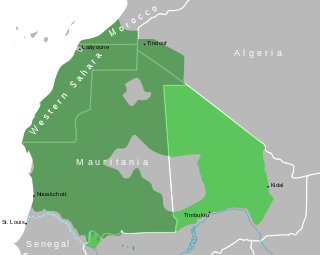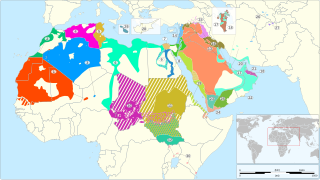
Arabic is a Central Semitic language of the Afroasiatic language family spoken primarily in the Arab world. The ISO assigns language codes to 32 varieties of Arabic, including its standard form of Literary Arabic, known as Modern Standard Arabic, which is derived from Classical Arabic. This distinction exists primarily among Western linguists; Arabic speakers themselves generally do not distinguish between Modern Standard Arabic and Classical Arabic, but rather refer to both as al-ʿarabiyyatu l-fuṣḥā or simply al-fuṣḥā (اَلْفُصْحَىٰ).
Modern Hebrew has 25 to 27 consonants and 5 to 10 vowels, depending on the speaker and the analysis.

Hassaniya Arabic is a variety of Maghrebi Arabic spoken by Mauritanian Arabs and the Sahrawi people. It was spoken by the Beni Ḥassān Bedouin tribes of Yemeni origin who extended their authority over most of Mauritania and Morocco's southeastern and Western Sahara between the 15th and 17th centuries. Hassaniya Arabic was the language spoken in the pre-modern region around Chinguetti.
In Semitic linguistics, an emphatic consonant is an obstruent consonant which originally contrasted with series of both voiced and voiceless obstruents. In specific Semitic languages, the members of this series may be realized as uvularized or pharyngealized, velarized, ejective, or plain voiced or voiceless consonants. It is also used, to a lesser extent, to describe cognate series in other Afro-Asiatic languages, where they are typically realized as ejective, implosive, or pharyngealized consonants.

Guttural R is the phenomenon whereby a rhotic consonant is produced in the back of the vocal tract rather than in the front portion thereof and thus as a guttural consonant. Speakers of languages with guttural R typically regard guttural and coronal rhotics to be alternative pronunciations of the same phoneme, despite articulatory differences. Similar consonants are found in other parts of the world, but they often have little to no cultural association or interchangeability with coronal rhotics and are (perhaps) not rhotics at all.
Mizrahi Hebrew, or Eastern Hebrew, refers to any of the pronunciation systems for Biblical Hebrew used liturgically by Mizrahi Jews: Jews from Arab countries or east of them and with a background of Arabic, Persian or other languages of Asia. As such, Mizrahi Hebrew is actually a blanket term for many dialects.
While many languages have numerous dialects that differ in phonology, the contemporary spoken Arabic language is more properly described as a continuum of varieties. This article deals primarily with Modern Standard Arabic (MSA), which is the standard variety shared by educated speakers throughout Arabic-speaking regions. MSA is used in writing in formal print media and orally in newscasts, speeches and formal declarations of numerous types.

Gulf Arabic is a variety of the Arabic language spoken in Eastern Arabia around the coasts of the Persian Gulf in Kuwait, Bahrain, Qatar, the United Arab Emirates, southern Iraq, eastern Saudi Arabia, northern Oman, and by some Iranian Arabs.
Suret, also known as Assyrian refers to the varieties of Northeastern Neo-Aramaic (NENA) spoken by Christians, namely Assyrians. The various NENA dialects descend from Old Aramaic, the lingua franca in the later phase of the Assyrian Empire, which slowly displaced the East Semitic Akkadian language beginning around the 10th century BC. They have been further heavily influenced by Classical Syriac, the Middle Aramaic dialect of Edessa, after its adoption as an official liturgical language of the Syriac churches, but Suret is not a direct descendant of Classical Syriac.
In the phonology of the Romanian language, the phoneme inventory consists of seven vowels, two or four semivowels, and twenty consonants. In addition, as with other languages, other phonemes can occur occasionally in interjections or recent borrowings.
Khuzestani Arabic is a dialect of South Mesopotamian Arabic spoken by the Iranian Arabs in Khuzestan Province of Iran. While it is a variety of SMA, it has many similarities with Gulf Arabic in neighbouring Kuwait. It has subsequently had a long history of contact with the Persian language, leading to several changes. The main changes are in word order, noun–noun and noun–adjective attribution constructions, definiteness marking, complement clauses, and discourse markers and connectors.

In Arabic and Maltese, the consonants are divided into two groups, called the sun letters or solar letters and moon letters or lunar letters, based on whether they assimilate the letter lām of a preceding Arabic definite article al- (الـ), which is an important general rule used in Arabic grammar. Phonetically, sun letters are ones pronounced as coronal consonants, and moon letters are ones pronounced as other consonants.
Baghdad Jewish Arabic or autonymhaki mal yihud or el-haki malna is the variety of Arabic spoken by the Jews of Baghdad and other towns of Lower Mesopotamia in Iraq. This dialect differs from the North Mesopotamian Arabic spoken by Jews in Upper Mesopotamian cities such as Mosul and Anah. Baghdadi and Northern Mesopotamian are subvarieties of Judeo-Iraqi Arabic.
The phonology of Bengali, like that of its neighbouring Eastern Indo-Aryan languages, is characterised by a wide variety of diphthongs and inherent back vowels.
Imāla is a phenomenon in Arabic comprising the fronting and raising of Old Arabic toward, and the old short toward. Imāla and the factors conditioning its occurrence were described for the first time by Sibawayh. According to as-Sirafi and Ibn Jinni, the vowel of the imāla was pronounced somewhere between and, suggesting a realization of.

Varieties of Arabic are the linguistic systems that Arabic speakers speak natively. Arabic is a Semitic language within the Afroasiatic family that originated in the Arabian Peninsula. There are considerable variations from region to region, with degrees of mutual intelligibility that are often related to geographical distance and some that are mutually unintelligible. Many aspects of the variability attested to in these modern variants can be found in the ancient Arabic dialects in the peninsula. Likewise, many of the features that characterize the various modern variants can be attributed to the original settler dialects as well as local native languages and dialects. Some organizations, such as SIL International, consider these approximately 30 different varieties to be separate languages, while others, such as the Library of Congress, consider them all to be dialects of Arabic.
This article explains the phonology of Malay and Indonesian based on the pronunciation of Standard Malay, which is the official language of Brunei, Singapore and Malaysia, and Indonesian, which is the official language of Indonesia and a working language in Timor Leste. There are two main standards for Malay pronunciation, the Johor-Riau standard, used in Brunei and Malaysia, and the Baku, used in Indonesia and Singapore.
This article is about the phonology of Egyptian Arabic, also known as Cairene Arabic or Masri. It deals with the phonology and phonetics of Egyptian Arabic as well as the phonological development of child native speakers of the dialect. To varying degrees, it affects the pronunciation of Literary Arabic by native Egyptian Arabic speakers, as is the case for speakers of all other varieties of Arabic.
PalatalizationPA-lə-tə-leye-ZAY-shən is a historical-linguistic sound change that results in a palatalized articulation of a consonant or, in certain cases, a front vowel. Palatalization involves change in the place or manner of articulation of consonants, or the fronting or raising of vowels. In some cases, palatalization involves assimilation or lenition.
The phonological system of the Hejazi Arabic consists of approximately 26 to 28 native consonant phonemes and 8 vowel phonemes:. Consonant length and vowel length are both distinctive in Hejazi.





